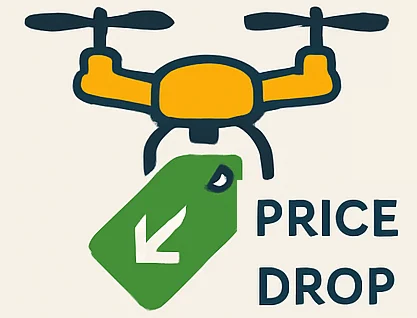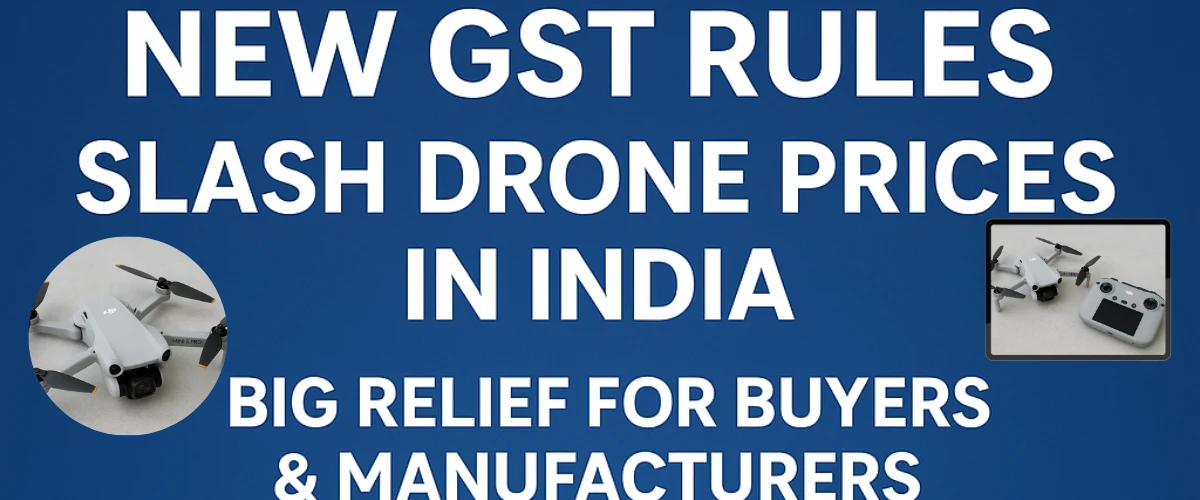The GST Council has moved to a uniform 5% GST (IGST/GST) on drones, plus exemptions for flight/motion simulators and certain high-performance batteries and communication equipment. That lowers the indirect tax on many commercial drones that were previously taxed at 18% (and many consumer/personal/other UAVs at 28%), and is expected to cut final retail/landed prices for many drone models in the ~10–18% range depending on prior classification and customs exposure.

Table of Contents
What the government actually changed
- Uniform GST of 5% on drones (applies to the GST/IGST head for drones).
- Exemptions: flight/motion simulators and some high-performance batteries and communication devices have been exempted, lowering training/ops costs.
- Context / timing: these changes were part of the GST rate rationalisation announced in early September 2025; the revised fitments were to take effect according to the Council/fitment committee timetable (public notices list mid- to late-September activation windows).
Why this matters for price
Lowering the GST rate shrinks the tax wedge that previously inflated retail or landed prices. For imports the IGST portion of the landed cost falls; for domestically made drones the GST component of the invoice falls.
Concrete example calculations
Assumptions (for clarity):
- “Base price” = price before GST (factory/ex-showroom or CIF before import taxes).
- Earlier common GST fits (before change): 18% for many commercial/camera drones, 28% on some “personal use / other” classifications (rules had been inconsistent).
The math below shows how consumer and commercial prices change when GST moves to 5%.
A. Retail / domestic sales (no customs)
| Model | Base price (INR) | Old final (18%) | Old final (28%) | New final (5%) | Absolute cut (18→5) | % cut (18→5) |
|---|---|---|---|---|---|---|
| Entry consumer | ₹30,000 | ₹35,400 | ₹38,400 | ₹31,500 | ₹3,900 | ~11.0% |
| Prosumer | ₹120,000 | ₹141,600 | ₹153,600 | ₹126,000 | ₹15,600 | ~11.0% |
| Enterprise / agri | ₹1,000,000 | ₹1,180,000 | ₹1,280,000 | ₹1,050,000 | ₹130,000 | ~11.0% |
(If product previously sat in 28% band, the absolute saving is larger and % cut rises to ~18% of the old final price — see table above for the two scenarios.) These numbers are straightforward multiplication: e.g. entry consumer new final = 30,000 × 1.05 = ₹31,500. (Calculations follow standard GST arithmetic.)
B. Imported drones (landed cost example)
Imports pay basic customs duty (BCD) + IGST on (CIF + BCD). Customs duties are not uniform: past advance rulings and classifications show BCD can vary widely (examples in public rulings range from about 10% up to very high ad-hoc levels for some models). That means GST cuts help proportionally but won’t eliminate high customs amounts.
Example (prosumer drone, base/CIF = ₹120,000):
- With BCD = 10%, taxable import value = 132,000. Old IGST at 18% → landed ≈ ₹155,760. New IGST at 5% → landed ≈ ₹138,600. Absolute reduction ≈ ₹17,160 (≈11.0% of landed).
- With BCD = 60% (high ruling seen for some hobby models), taxable value = 192,000. Old IGST (18%) → landed ≈ ₹226,560. New IGST (5%) → landed ≈ ₹201,600. Absolute cut ≈ ₹24,960 (≈11.0% of landed).
Notice: the percentage reduction from IGST change is the same (~11% here) because IGST is applied to the same taxable base — but the absolute rupee amount grows if customs duty is higher. (So importers with high BCD still see savings, but customs remains the dominant cost for some SKUs.)
Market impact — who benefits, who should watch out
Winners
- Commercial buyers and fleet operators (agriculture, inspection, mapping): lower per-unit costs improve ROI and total cost of ownership; economics of larger deployments improve.
- Indian drone manufacturers & startups: cheaper GST narrows price gap to imports and supports scale/R&D investments.
- Training and simulation providers: simulators exempted → lower training costs, easier skilling.
Watch-outs / losers
- Imported consumer hobby drones where customs/BCD is high — customs still dominates landed cost. Some advance rulings imposed very high BCDs on select micro-models; those will remain expensive unless customs policy changes.
- Companies with existing inventory pre-announced prices — they may need repricing/label changes and will face operational switching costs (some transitional relief was announced on packaging MRPs but verify timelines).
Wider policy & risk factors to monitor
- Customs tariff / AIDC changes: India has been actively revising tariff structure; import duty volatility (and geo-trade frictions) can offset GST gains. Keep an eye on customs notifications and AIDC (agriculture infrastructure development cess) changes.
- Classification disputes: HSN classification has driven prior oddities (18% vs 28% vs very high import rulings). Uniform 5% should reduce disputes for domestic supply chains but some borderline items might still face clarity issues.
The new 5% rule is live/rolling in late-Sept 2025 and retailers should start reflecting it; otherwise ask suppliers for a post-GST recalculation.
Join us on Telegram Group , Instagram for the Latest Aviation Updates.
Also read: Why Airlines Strictly Ban Coconuts: Dangerous Safety and Security Risks Revealed – AeroTexts


8 thoughts on “New GST Rules Slash Drone Prices in India — Big Relief for Buyers & Manufacturers”